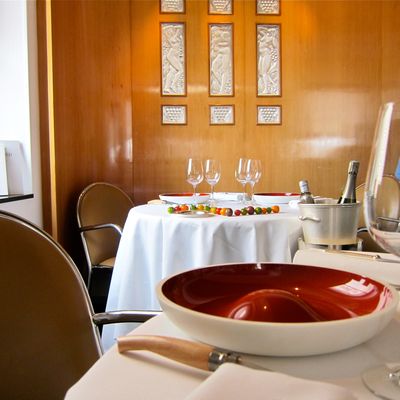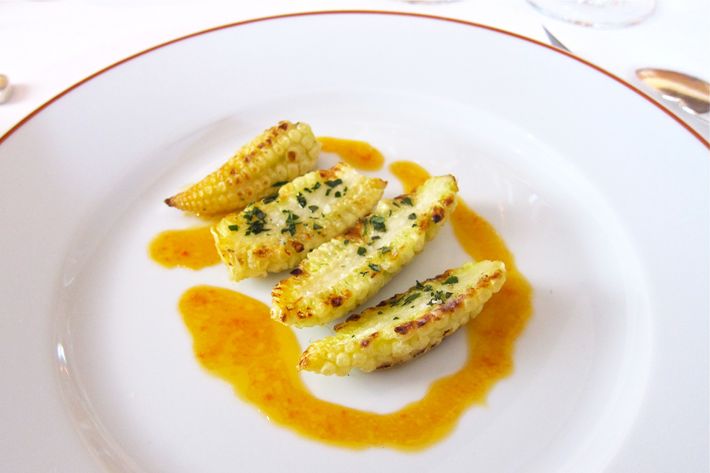
When it comes to the age-old debate on the culinary merits of Paris versus New York, any worthwhile New Yorker will tell you that, lately, their city has the upper hand. The days when Paris was the absolute, unquestioned epicenter of the food and restaurant world are long gone. Food lovers no longer flock to Paris for regular periods of study and worship. And today’s globe-trotting chefs find their inspirations all over (Tokyo, San Sebastian, the streets of Bangkok, the piney woods around Copenhagen), and if you’re a curious young gastronome in New York (or Nashville, or Portland, Oregon), why visit Paris for the latest culinary fashions and trends when you can trawl food sites on the internet, binge-watch old episodes of No Reservations, or just hop a train to Bushwick and see everything yourself?
I know these arguments well because, as a jaded, self-important, New York-based glutton, I’ve made them many times myself. But having recently visited Paris after a long interlude away, I’d like to amend them slightly. Sure, there’s only one Michelin-starred Italian restaurant in the entire City of Light, and, for a visiting New Yorker, many of Paris’s “trendy” hot spots have a familiar ring to them (the corned-beef sandwich at Frenchie to Go was the dish that fashionable Parisians kept nattering on about), but as I wandered the boulevards, reacquainting myself with the ancient delicacies that have been cast aside by trend-happy New Yorkers (a good soufflé, a range of light wines, a carefully fashioned dessert selection), it struck me that, these days, both cities’ strengths and weaknesses dovetail in a complementary way.
If a trip to New York is a window into the clamorous, post-millennial world of modern dining, then for trend-addled, umami-saturated New Yorkers, a trip to Paris has a soothing, almost palate-cleansing effect. It’s like leaving the hubbub of Rome for the neatly tended streets of ancient Athens: The dining rooms are quieter, the service is more courtly and professional, and the meals, even if they’re familiar, proceed at a more stately, civilized pace. The grand old restaurants of Paris have for the most part aged better than the grand old restaurants of New York, and, for a number of reasons, the city’s august chefs aren’t under the same pressure to expand (i.e., open a burger bar) and innovate the way their contemporaries are on this side of the Atlantic. When I visited Alain Passard’s famous vegetable-forward l’Arpege, I was surprised by how small the room seemed compared to, say, Daniel or Le Bernardin. When I asked Passard if he’d ever considered opening a restaurant in New York, he gave me a slightly horrified look: “Why would I do that?” he said. “I’ve never even been to New York.”

Daniel Rose, who grew up in Chicago and now runs a fine restaurant near the Louvre called Spring, says that whenever he returns to Paris after visiting the clamorous eateries of Brooklyn and Manhattan, it takes him a couple of weeks to get his head straight. The dizzying procession of fads can be exhausting. “Last year in New York, southern fried cooking was the cool thing, and now vegetables are in vogue,” Rose says a little wearily. “The French have always been into vegetables and they’ll still be into vegetables long after the fad has ended in the States.” Rose also points out that resolutely un-faddish Parisians still build meals around a variety of wines, meaning the food tends to be more subtly flavored than the umami-bomb dishes of New York, and that French restaurant ingredients are more rigorously seasonal and, generally, higher quality (he’s right; the Hudson Valley has its charms, but even this NYC booster agrees that it doesn’t compare to the bounty of the Loire Valley).
Not that Paris is perfect, of course. For citizens of today’s polyglot, endlessly changing dining scene, keeping track of a frenetic carousel of restaurant fads is half the fun, of course, and there are only so many delicately rendered soufflés you can enjoy before you begin pining for a good old-fashioned slice of Crack Pie. After several days dining in hushed restaurants on creamy veloutes and platters of perfectly cooked asparagus, I asked around to see where I could find a proper umami fix. The pizza was of the delicate, faux-Neapolitan variety, my sources said, and although there were some decent burgers, they weren’t on par with standard burgers in the States. I was directed to the city’s fashionable new steak-frites joint of the moment, a place on the Left Bank, with a familiar, stripped-down look. The tiny room was filled with merry Parisians — many of them sporting facial whiskers and Brooklyn plaid — eating hunks of beef that, it transpired, had been flown in, most likely frozen, from Texas. I took two bites of my very ordinary steak “de Black Angus” and put down my fork. It was time to go back to New York.





